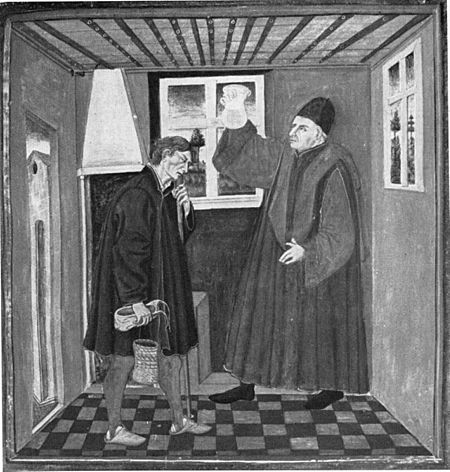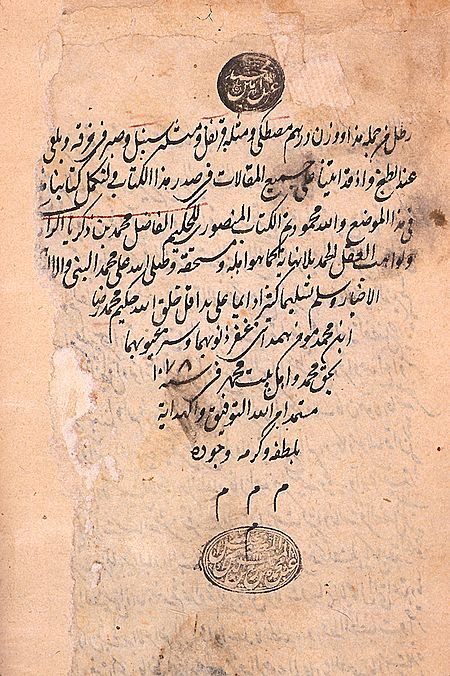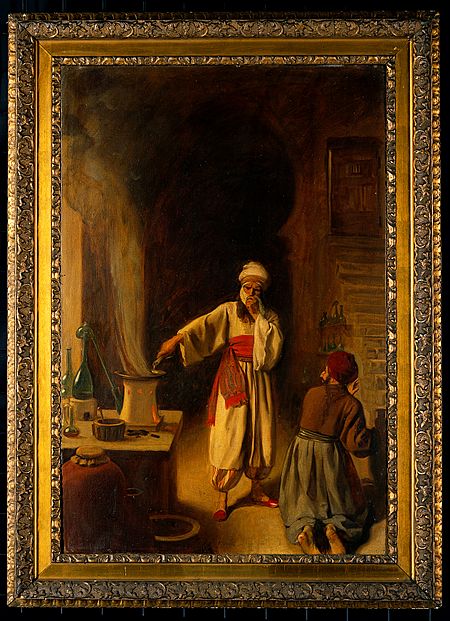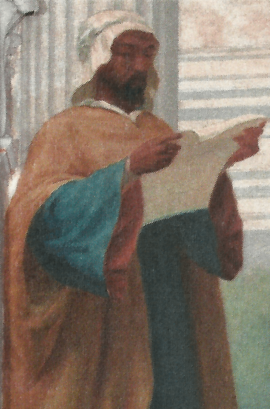Abu Bakr al-Razi facts for kids
Quick facts for kids
Abū Bakr al-Rāzī
|
|
|---|---|
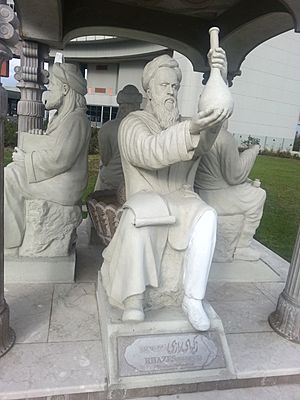
Statue of al-Razi in the Scholars Pavilion
|
|
| Born | 864 or 865 CE 250 or 251 AH Ray (Iran)
|
| Died | 925 (aged 60–61)
CE or 313 or 323 AH Ray (Iran)
|
| Era | Islamic Golden Age |
|
Main interests
|
Medicine, philosophy, alchemy, criticism of religion |
|
Notable ideas
|
The first to write up limited or extensive notes on diseases such as smallpox and chickenpox, a pioneer in ophthalmology, author of the first book on pediatrics, making leading contributions in inorganic and organic chemistry, also the author of several philosophical works. |
Abū Bakr al-Rāzī (full name: أبو بکر محمد بن زکریاء الرازي, Abū Bakr Muḥammad ibn Zakariyyāʾ al-Rāzī), often known as (al-)Razi or by his Latin name Rhazes, was a brilliant Persian physician, philosopher, and alchemist. He lived during the Islamic Golden Age, a time when science and learning thrived.
Al-Razi is considered one of the most important people in the history of medicine. He also wrote about logic, astronomy, and grammar. He was known for his unique philosophical ideas, including a belief in five "eternal principles."
He was a deep thinker who made lasting contributions to many fields. He wrote over 200 books and papers. He is especially remembered for his many advances in medicine. He used experimental medicine, which means he tested his ideas.
Al-Razi became a very successful doctor. He was the chief physician at hospitals in Baghdad and Ray. He taught medicine and was known for being kind to his patients, whether they were rich or poor. He was the first to clearly tell the difference between smallpox and measles. He also suggested good ways to treat smallpox.
His medical books were translated and became well-known in Europe. They greatly influenced how medicine was taught in Western universities. Some people call him the "father of pediatrics" (children's medicine). He was also a pioneer in obstetrics (childbirth) and ophthalmology (eye care). He was the first doctor to notice how the eye's pupil reacts to light.
Contents
Biography
Al-Razi was born in the city of Ray. This city is in modern Iran and was on the Great Silk Road. The Silk Road helped trade and cultural exchange between East and West. Ray is located near Tehran, Iran.
When he was young, al-Razi moved to Baghdad. There, he studied and worked at a local hospital, called a bimaristan. Later, the governor of Ray, Mansur ibn Ishaq, invited him back to lead a hospital there. Al-Razi wrote two medical books for Mansur ibn Ishaq.
Because he became so famous as a doctor, al-Razi was invited back to Baghdad. He became the director of a new hospital. Later, he was asked to build an even bigger hospital. To choose the best location, al-Razi used a clever method. He hung fresh meat in different parts of the city. He decided to build the hospital where the meat took the longest to spoil. This showed the air was cleaner there.
In his later years, al-Razi lived in his hometown of Rey. He suffered from glaucoma, an eye disease, and eventually became completely blind. Once, a doctor offered to treat his blindness. Al-Razi asked him how many layers the eye has. When the doctor couldn't answer, al-Razi refused the treatment. He said his eyes wouldn't be treated by someone who didn't know the basics of eye anatomy.
Al-Razi's lectures attracted many students. He was seen as a shaikh, which is an honored title for a teacher. He had different groups of students. If a question came up, it would go to the first group of students. If they couldn't answer, it went to the next group, and so on. Only if all students failed, al-Razi himself would answer.
Al-Razi was a very kind and generous person. He treated poor patients for free. He even wrote a book called Who Has No Physician to Attend Him. This book gave medical advice to people who couldn't see a doctor. After his death, his fame spread far beyond the Middle East. His ideas continued to influence medicine for centuries.
Contributions to Medicine
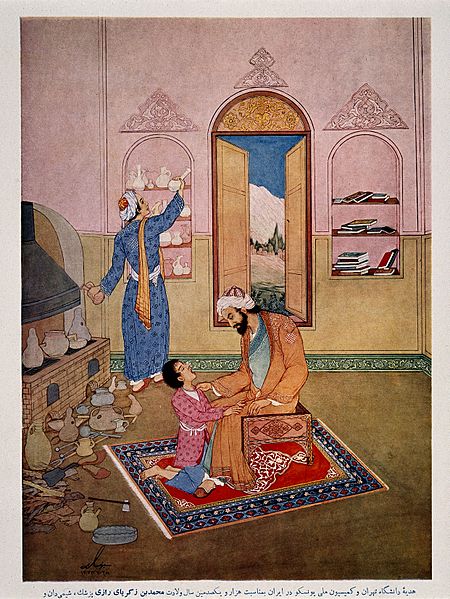
Al-Razi was one of the world's first great medical experts. He is sometimes called the father of psychology and psychotherapy.
Smallpox vs. Measles
Al-Razi's book al-Judari wa al-Hasbah (On Smallpox and Measles) was the first book to describe these two diseases as different from each other. This book was translated many times into Latin and other European languages. It showed al-Razi's medical approach, which relied on careful observation of patients.
Meningitis Research
Al-Razi studied patients with meningitis. He compared those treated with blood-letting to those who were not. He wanted to see if blood-letting was helpful for this condition.
Pharmacy Advances
Al-Razi greatly helped the early practice of pharmacy. He wrote texts that introduced the use of "mercurial ointments." He also developed tools like mortars, flasks, spatulas, and phials. These tools were used in pharmacies for a long time.
Medical Ethics
Al-Razi brought in many practical and forward-thinking ideas about medicine. He spoke out against charlatans and fake doctors. These people traveled around selling false "cures." At the same time, he warned that even highly trained doctors couldn't cure all sicknesses.
To be better doctors, al-Razi advised them to keep learning. He told them to study medical books and learn new information. He also explained the difference between diseases that could be cured and those that couldn't. He said doctors shouldn't be blamed if they couldn't cure advanced cases of cancer or leprosy.
Important Medical Books
- Al-Kitab al Hawi
This huge medical encyclopedia has 23 volumes. It covers topics like gynecology (women's health), obstetrics (childbirth), and eye surgery. In Europe, it was known as The Large Comprehensive. Many scholars believe this book alone makes al-Razi the greatest medical doctor of the Middle Ages.
Al-Hawi was a collection of al-Razi's working notes. It included knowledge from other books and his own observations. It is important because it has a famous section on smallpox, which is the earliest known. This book was translated into Latin in 1279 and had a big impact in Europe.
Al-Razi also used Al-Hawi to question the ideas of Galen, a famous Greek physician. Al-Razi had seen many patients whose fevers didn't match Galen's descriptions. For example, he said Galen's descriptions of urinary problems were wrong. Galen had only seen three cases, while al-Razi had studied hundreds in hospitals.
- For One Who Has No Physician to Attend Him (Man la Yahduruhu Al-Tabib)
Al-Razi was probably the first Persian doctor to write a home medical guide for everyone. He wrote it for the poor, travelers, and ordinary people. They could use it to treat common sicknesses when a doctor wasn't available. This book is important for the history of pharmacy.
In its 36 chapters, al-Razi described diets and medicines. These could be found in a pharmacy, a market, or even in a well-stocked kitchen. He explained how intelligent people could follow his instructions to prepare remedies. He covered illnesses like headaches, colds, coughs, and eye problems.
- Book for al-Mansur (Kitāb al-Manṣūrī)
Al-Razi dedicated this book to his patron, Abū Ṣāliḥ al-Manṣūr, the governor of Ray. A Latin translation of this work was later edited in the 16th century.
- Doubts about Galen (al-Shukūk ʿalā Jalīnūs)
In this book, al-Razi disagreed with some of the Greek physician Galen's ideas. He believed that good medical practice needed independent thinking. He noted that Galen's descriptions of fevers didn't match what he saw in his own patients.
He also questioned Galen's theory that the body had four "humors" (liquid substances). Galen believed the balance of these humors controlled health and body temperature. Al-Razi observed that a warm drink would heat the body much more than its own temperature. This showed the body reacted to the drink, rather than just taking its warmth.
Al-Razi's challenges to existing medical theories were quite bold for his time.
- The Diseases of Children
Al-Razi's book The Diseases of Children was the first book to treat pediatrics (children's medicine) as its own separate field.
Alchemy
Al-Razi was very interested in alchemy. He strongly believed that it was possible to change less valuable metals into silver and gold. After his death, people said he had found the secret to turning iron and copper into gold.
Major Works on Alchemy
Al-Razi's alchemy books were the first to systematically classify chemical substances and reactions. He described them in a clear way, without much mystery.
- The Secret (Al-Asrar)
- This book was written for his friend and former student, Abu Muhammad ibn Yunis al-Bukhari.
- Secret of Secrets (Sirr al-Asrar)
- This is al-Razi's most famous book on alchemy. In it, he carefully explains basic chemical operations important to the history of pharmacy.
- In Sirr al-Asrar, al-Razi divided "matter" into three main groups:
- Knowing and identifying medical parts from plants, animals, and minerals. He described the best types for medical treatments.
- Knowing the equipment and tools used by alchemists or apothecaries (pharmacists).
- Knowing seven alchemical procedures and techniques. These included things like changing mercury, sulfur, and arsenic, and turning minerals into other forms.
-
- This last group also described other methods used in transmutation:
- Mixing and using solvents.
- The amount of heat (fire) to use.
- Using a liquid that could quickly and permanently color metals for better sales.
- This last group also described other methods used in transmutation:
- Al-Razi also explained how to color a silver object to look like gold. He also described how to remove the color to make it silver again. He explained how these colors could last for years without fading.
- Al-Razi classified minerals into six groups:
- Four spirits: mercury, sal ammoniac, sulphur, and arsenic sulphide.
- Seven bodies (metals): silver, gold, copper, iron, black lead, zinc, and tin.
- Thirteen stones: Marcasite, magnesia, malachite, tutty (zinc oxide), talcum, lapis lazuli, gypsum, azurite, haematite (iron oxide), arsenic oxide, mica, asbestos, and glass.
- Seven vitriols: alum and different colored vitriols (impure sulfates of iron, copper, etc.).
- Seven borates: natron and impure sodium borate.
- Eleven salts: including brine, common salt, ashes, naphtha, live lime, and urine.
- Al-Razi also listed the equipment used in alchemy. This included tools for melting metals, like a blacksmith's hearth and crucible. It also included tools for chemical processes, like retorts, alembics, glass cups, and mortars.
Philosophy
Al-Razi wrote many books on philosophy, but most of them are now lost.
Metaphysics
Al-Razi's ideas about metaphysics (the nature of reality) came from his theory of "five eternals." He believed the world was created from the interaction of God and four other eternal principles: soul, matter, time, and place. He also believed in a type of atomism, where bodies are made of tiny, unchanging particles. He was influenced by Plato and medical writers like Galen. However, he often thought for himself and disagreed with some of their views. This is clear from his book Doubts About Galen.
Views on Reason and Truth
Some sources say that al-Razi believed all humans could find truth through their God-given reason. He thought that everyone has an equal basic ability to understand and discover truth. Differences in this ability, he believed, came from how much interest, opportunity, and effort a person put in. Because he focused so much on reason, some people saw him as a freethinker.
Al-Razi also wrote about the importance of using reason to understand the world. He believed that people should not just accept ideas without thinking about them. He encouraged independent thought and questioning.
Legacy
Today, the Razi Vaccine and Serum Research Institute and Razi University in Iran are named after him. Iran celebrates "Razi Day" (Pharmacy Day) every year on August 27th.
In 2009, Iran gave a "Scholars Pavilion" to the United Nations Office in Vienna. This pavilion has statues of al-Razi and other famous scholars like Avicenna, Abu Rayhan Biruni, and Omar Khayyam.
Historian George Sarton called al-Razi the "greatest physician of Islam and the Medieval Ages." The Bulletin of the World Health Organization noted that his writings on smallpox and measles were original and accurate. His essay on infectious diseases was the first scientific book on the topic.
See also
 In Spanish: Al-Razi para niños
In Spanish: Al-Razi para niños
- List of Iranian scientists
- Medical Encyclopedia of Islam and Iran
- Medical literature
Images for kids



